Unmasking the Deceptive Operations Behind the Sonalez.com Crypto Scam

Sonalez.com Crypto Scam Details
Sonalez.com is a scam website that tricks people with promises of free Bitcoin and big profits through fake endorsements by famous people like Elon Musk, Warren Buffett, and others. They use fake videos and photos to make it look real. They spread these scams on social media, like TikTok and Facebook, and through spam emails. They even give people unique codes to sign up.
But here’s the truth: Sonalez.com has nothing to do with these celebrities. They don’t have any real contact information, and the free Bitcoin they promise doesn’t exist. If you send them money, you won’t be able to get it back. It’s a big red flag for a scam.
Sonalez.com uses all sorts of tricks to fool people. They don’t tell you who they are, and they use technology to fake celebrity endorsements. They pressure you to send them money and promise huge returns on your investment. But it’s all a lie. Sonalez.com is just one part of a bigger network of scams that steal money from people all around the world.
If you fall for Sonalez.com’s promises of free Bitcoin and easy money, you’ll likely lose your money, and there’s little chance of getting it back. They’re very good at making their scams look real and getting people to believe in cryptocurrency investments.
In a nutshell, Sonalez.com is a scam that pretends to give you free Bitcoin and big profits with the help of famous people. But it’s all fake. They use fake videos and photos, pressure you to send them money, and once they have your money, it’s gone. Sonalez.com is just one of many scams out there, so be careful and don’t fall for it. If you’ve been scammed, report it and warn others.
How does the Sonalez.com Scam trick people?

Sonalez.com is a tricky cryptocurrency scam. They say you’ll get free Bitcoin and big profits with endorsements from famous folks like Elon Musk. But it’s all a lie. They use fake videos and pictures to make it look real. In truth, there’s no free crypto or easy money here.
Sonalez.com has lots of warning signs. They don’t tell you who they are, and you can’t get your money back. They mess with your mind, making you believe you’re getting rich.
Sonalez.com tricks people through a step-by-step plan that uses psychology to make you send them your cryptocurrency.
Here’s how Sonalez.com crypto scam works, broken down into simple steps:
Step 1: Social Media Advertisements
The scam begins with fake ads on platforms like TikTok, Facebook, and Instagram. These ads show fake endorsements from celebrities like Elon Musk, but they’re not real. They even use technology to create videos that look like the celebrities are promoting a new cryptocurrency called Sonalez.com. They also make fake screenshots to make it seem more convincing. To make it even more tempting, they promise free cryptocurrency and big profits.
Step 2: Directing Users to Sonalez.com Website
These ads include a special code, and they tell you to go to the Sonalez.com website and enter this code to get your free cryptocurrency. They try to rush you by saying the offers are limited, but in reality, this code is just used to keep track of who falls for the scam. When you go to the Sonalez.com website, it looks professional, but it’s all fake. They use stock photos, more fake quotes from celebrities, and even paid testimonials. There are no real company details, owners, or legal information on the site. It’s all part of a network of scam websites.
Step 3: Registration and Confirming Account Balances
To sign up, you have to give your personal information like your name, email, and phone number. You think you need to do this to get the free Bitcoin they promised. After you sign up, the website shows a balance of Bitcoin in your account, even though it’s not real. But victims believe they’ve received their free Bitcoin from the fake celebrity endorsements. In reality, the site is just tracking your info, but it never actually pays out any cryptocurrency. The fake balance tricks people into going further into the scam.
Step 4: Requirements for Withdrawal Deposits
Despite showing a big balance, Sonalez.com doesn’t let you withdraw the money directly. Instead, they say you need to make a deposit of $200 to $500 to activate withdrawals. They claim it’s for ID verification and to trigger the payouts. If you hesitate or refuse, their customer service pushes you to do it, even making up fake policies and penalties. But once you send the cryptocurrency, your money gets stuck, and you can’t send it anywhere.
Step 5: Persisting Cryptocurrency Extortion Scheme
After the initial deposit, Sonalez.com blocks your attempts to withdraw your money, often saying there are issues with ID verification. When you contact their customer service, they make up new problems that require even more payments to fix. They might say you need to pay for upgraded verification, taxes, or network costs. They keep coming up with excuses, and each payment brings more fake barriers. They do this to take as much money as possible. Once they’ve taken everything they can, they disappear, and you can’t get in touch with them.
Step 6: Closing Accounts, Vanishing Act
After they’ve taken thousands of dollars in deposits, Sonalez.com blocks your access to the site and closes your account. Their customer service vanishes, and you have no way to get your stolen money back. Sonalez.com doesn’t have any real company information, so you can’t seek justice.
The website may run for a few months before they take it down and start the same scheme with a new name and new ads on social media, but it’s the same deceitful tactics. So, remember to avoid engaging with or sending money to platforms like this.
How can one spot and evade the Sonalez.com Crypto Scam?

To avoid falling into the trap of scams like Sonalez.com, you need to watch out for some common warning signs. Here’s how to protect yourself:
- Fake Celebrity Endorsements and Unrealistic Promises
If a crypto platform claims that famous people endorse it or promises unrealistically high returns like 400%, be cautious. Scammers often use these tactics to create a sense of urgency and fear of missing out (FOMO). They even use technology to fake endorsements, so don’t believe everything you see.
- Suspicious Social Media Posts and Fake Reviews
Watch out for low-quality social media posts with fake reviews and comments. Scam platforms like Sonalez.com often rely on fake engagement to seem legitimate. Instead, trust user ratings on reputable review sites to make decisions.
- High-Pressure Sales Tactics and Limited-Time Offers
Scammers use tactics like scarcity and urgency to push you into making quick decisions. They’ll claim you need to act immediately to grab a special deal. Don’t fall for this pressure; take your time to research and think before you invest.
- Lack of Company Details and Owners
Check if the website provides legitimate company registration, an address, or information about its owners. Sonalez.com and other scams often hide behind anonymity to avoid accountability. Legitimate businesses always share these details.
- Deposits Required Before Withdrawal
Be cautious if a platform insists that you must deposit money before you can withdraw your funds. Scammers show fake account balances and then demand fees before you can access your money. Legitimate platforms won’t block you from your own funds or ask for payments upfront.
- Unspecified Web Hosting and Registration
Check where the website is hosted and who registered the domain. Scammers like Sonalez.com use offshore hosting and anonymous domain registration to stay hidden. You can use sites like Whols.com to verify if a business’s details are genuine. Avoid platforms with hidden owners.
To stay safe, be on the lookout for these warning signs when you come across a cryptocurrency website or offer. If anything seems fishy or too good to be true, don’t share your personal information or make any payments. Stick with well-known and regulated platforms that have a proven track record over time. It’s better to be cautious and protect your hard-earned money from potential scams.
Spotting the Sonalez.com Scam on Various Social Media Channels

The Sonalez.com scam spreads across different social media platforms like Facebook, TikTok, and Instagram to reach as many people as possible with their deceptive offers and fake celebrity endorsements. Here’s how to spot their scam posts on each platform:
Facebook Red Flags
- Look out for Sonalez.com ads and posts with catchy, clickbait headlines that sound too good to be true.
- Check for unusual engagement on their page and posts; scammers may use fake accounts to like and comment.
- Be wary if you see images of celebrities promoting Sonalez.com, as these are often stolen from other sources.
- Watch for obviously photoshopped images of famous people with Sonalez.com branding.
- Be cautious of comments filled with spammy referral links and automated bot responses.
TikTok Warning Signs
- Scammers may use flashy images of money and luxury items to grab your attention.
- Be suspicious of comments from bots and fake followers that are incentivized to make the scam look more credible.
- Watch out for deep fake videos of celebrities endorsing the scam; these are created with artificial intelligence.
- Be cautious if you see screenshots of fake wealth that are edited to show Sonalez.com’s involvement.
- Pay attention to link spam and overlays that aggressively push you to take action.
Instagram Red Flags
- Be cautious if you see the Sonalez.com handle tagged on unrelated, popular posts; scammers may try to hijack trending topics.
- Look out for link spam and aggressive captions that urge you to click on their offers.
- Be wary of tag spam from large bot follower networks that artificially boost their presence.
- If you notice repurposed celebrity deep fakes from TikTok, it’s a big red flag.
- Don’t trust endorsements that use edited or stolen celebrity photos to make the scam seem more convincing.
The best way to protect yourself is to avoid investment opportunities that heavily rely on social media promotion without proper registration and documentation. Legitimate businesses will have clear contact information and details about their owners on their official websites. Be cautious, and if something seems too good to be true, it’s essential to do your research and verify the authenticity of any investment offer before getting involved.
What should individuals do after being defrauded by the Sonalez.com Crypto Scam?

If you’ve fallen victim to the Sonalez.com crypto scam, the road to reimbursement can be challenging due to the fraudulent nature of the website. However, there are steps you can take to mitigate the damage and potentially help law enforcement shut down the scam:
Reset All Account Passwords and Enable Two-Factor Authentication – Since scammers have access to your personal information, the first step is to reset all your account passwords. This includes your email, financial accounts, crypto wallets, and any other sensitive logins. Additionally, enable two-factor authentication for extra security on important accounts. Keep a close eye on your credit reports and account activities for any unusual or unauthorized transactions.
Report the Scam to Relevant Authorities – To combat the scam and prevent others from falling victim, it’s crucial to report Sonalez.com to various authorities and organizations. This includes:
- Informing the social media platforms where you encountered the scam, such as Facebook, TikTok, Instagram, YouTube, and others.
- Filing a complaint with the Consumer Financial Protection Bureau (CFPB) complaint portal.
- Contacting payment systems and card issuers (e.g., Visa, PayPal, Mastercard) for transactions made to Sonalez.com.
- Reporting the scam to your local police, specifically the cybercrime and fraud departments.
- Informing domain name registrars like GoDaddy, which can potentially disable the scam website.
- Using the Federal Trade Commission (FTC) Complaint Assistant to report the scam.
- If you used cryptocurrency exchanges for transactions (e.g., Binance, Coinbase), contact them regarding your payments.
Providing as much documentation as possible can assist law enforcement in their investigation and potentially lead to restitution.
Consult Legal Options – Consider consulting with an attorney or legal clinic to explore potential recourse. While it’s challenging, victims have sometimes been able to recover stolen funds through civil lawsuits or class action cases. An attorney can guide you on the best approach for your specific situation.
Document All Activities and Losses – Gather evidence and document all interactions with Sonalez.com. Take screenshots of your account, transaction recipients, emails, and message logs. Keep a record of all the money, cryptocurrency, or personal data that you lost. Creating a comprehensive record of damages is crucial. Print and store your documentation securely.
Cease All Engagement with the Scam – Immediately stop any further interaction with Sonalez.com. Avoid visiting the website, responding to emails, or contacting customer service representatives. Continued engagement may only result in scammers attempting to extract more payments from victims.
Install an Ad Blocker – Installing an ad blocker can help you avoid malicious ads or phishing attempts. Scammers may target victims with additional scams in the future, and an ad blocker provides an extra layer of protection.
Run a Malware Scan – Run a malware scan on your devices using a trusted antivirus program to check for viruses or spyware from the scam site. If any issues are detected, remove them immediately to safeguard your device and data.
Warn Others About the Scam – Spread awareness about the tactics used by Sonalez.com and similar crypto scams within your social circles and online communities. Share your experience and caution others to thoroughly check websites before sending payments or personal data. Your story can help prevent someone else from becoming a victim of such scams.
In summary, if you’ve been scammed by Sonalez.com or a similar fraudulent scheme, it’s essential to take immediate action to protect yourself, report the scam, and potentially aid in its shutdown. While recovery may be challenging, these steps can improve your chances of mitigating the damage and preventing others from falling into the same trap. Stay vigilant and prioritize your online security to avoid falling victim to scams in the first place.
Special Offer
In order to remove Sonalez.com hassle free, we suggest you to scan the PC with powerful SpyHunter antimalware scanner. The fully functional free Trial of SpyHunter is Available for 7 days (Windows Version) with Credit Card required. There are no upfront charges within this period. Further, no charge will apply if you cancel 2 business days before the trail ends. For Mac Users, it is suggested to use Combo Cleaner which is a powerful antivirus and System optimizer.
Do make sure to read SpyHunter’s EULA and Privacy Policy. Spyhunter free scanner downloaded just scans and detect present threats from computers and can remove them as well once, however it requires you to wait for next 48 hours. If you intend to remove detected threats instantly, then you will have to buy its licenses version that will activate the software fully.
How to remove unwanted program from Windows 11
To get rid of an unsafe program on your Windows computer, follow these straightforward steps:
- Open your computer's settings by pressing "Windows + I" or right-clicking the "Start" button and choosing "Settings."

- In the settings window, click on "Apps" and then select "Apps & Features."
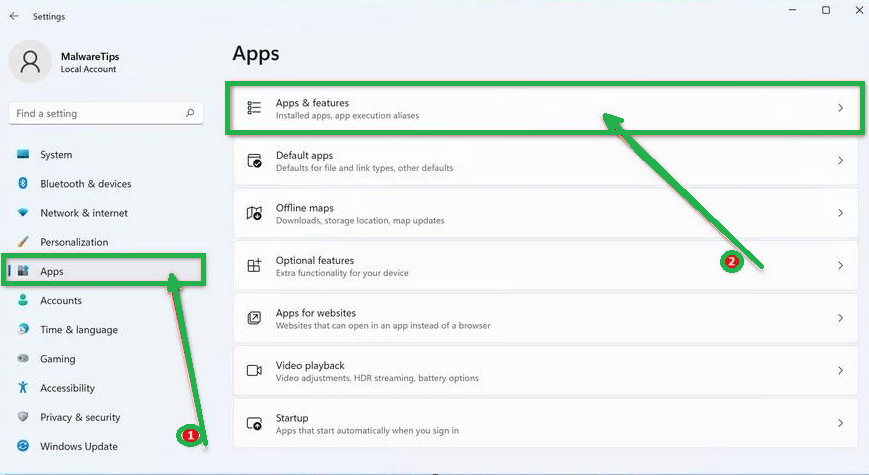
- You'll see a list of installed programs. Scroll through them and look for anything suspicious or unfamiliar. To make it easier, you can sort the list by the installation date. Just click "Sort by" and pick "Install date."
- Keep an eye out for any programs that don't seem right – things you don't remember installing or that don't sound like legitimate software. When you find a suspicious program, click the three dots next to it and choose "Uninstall."

- A message box will pop up. Confirm the uninstall process by clicking "Uninstall" and follow any prompts that come up to complete the removal.
- It's crucial to read all the prompts carefully because some malicious programs might try to sneak in extra things, hoping you won't notice.

- Once you've successfully removed the malicious programs from your computer, you've taken a big step in getting rid of the unwanted program.
How to Remove Unwanted program Virus from Windows 10
To remove an unwanted program from a Windows 10 computer, follow these steps:
- Open the "Settings" app by press the "Windows key + I" on your keyboard. Alternatively, you can click the "Start" button on the taskbar and then choose "Settings" (the gear icon).
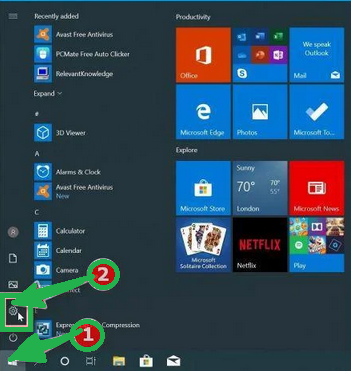
- In the "Windows Settings" window, you'll see various options. Click on "Apps." By default, it should take you to "Apps and Features," but if not, select it from the options on the left.
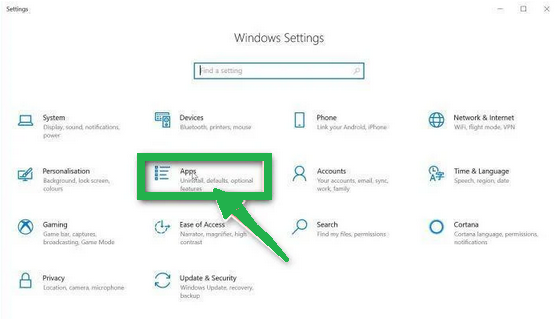
- In the "Apps & Features" settings, scroll through the list of installed programs. Look for anything that seems unfamiliar or suspicious. To help with this, you can sort the programs by their installation date. To do this, click "Sort by" and pick "Install date."
- Keep an eye out for any program that you don't remember downloading or that doesn't seem like a legitimate piece of software. When you find a suspicious program, click on it and then choose "Uninstall" from the menu that appears.

- A message box will pop up to confirm the uninstallation process. Click "Uninstall" to confirm and follow any additional prompts that come up to complete the removal.
- It's essential to carefully read all the prompts because some malicious programs might try to sneak in additional things during the process, hoping you won't notice.

- Once you've gone through these steps successfully, the malicious program will be removed from your computer.
How to Remove Unwanted program Virus from Windows 7
To remove an unwanted program from Windows 7, follow these steps:
- Click the "Start" button and select "Control Panel."
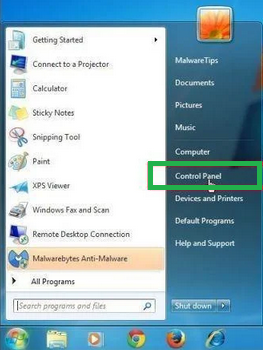
- In the Control Panel, click "Uninstall a Program" under the "Programs" category.

- You'll see a list of all installed programs in the "Programs and Features" screen. Find any suspicious or unfamiliar programs, click to highlight them, and then click "Uninstall."
- Look for anything that doesn't seem legitimate or you don't remember installing.

- Confirm the uninstallation in the message box by clicking "Yes" and follow any prompts to complete the removal. Read carefully, as some malicious programs try to slip in unnoticed.
- Once you've completed these steps, the malicious software will be removed from your computer.
How to Remove Unwanted program from Android/Mobile
To remove an unwanted program virus from your Android phone, follow these simple steps:
Step 1: Start in Safe Mode
First, we'll start your phone in Safe Mode. Safe Mode boots your Android with only the essential apps and settings, preventing malicious apps from interfering.
- Long-press your phone's power button (usually found on the side of your phone) until the power off menu appears.
- When the menu appears, tap and hold the "Power off" button on your screen. You'll see a "Safe mode" option.

- Tap on "Safe mode" to enter it.
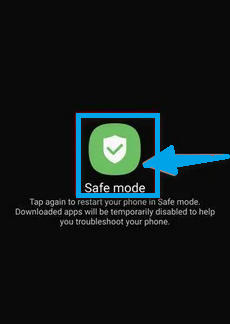
- Your phone will restart in Safe Mode, and you'll see the "Safe Mode" text at the bottom left corner of your device.
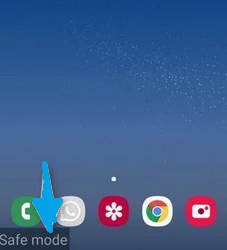
If you can't find Safe Mode on your phone, you can activate Airplane mode instead to cut off network connections.
Step 2: Check for Malicious Apps with Administrator Privileges
In this step, we'll check if there are any malicious apps with administrator privileges on your phone. These privileges are sometimes used for legitimate purposes but can also be exploited by malicious apps to prevent their removal.
- Tap the "Settings" app on your phone's menu or home screen.
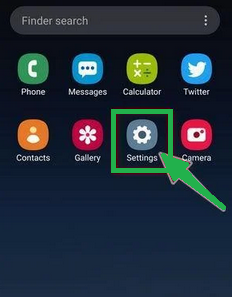
- In the "Settings" menu, look for "Biometrics and Security" (or similar) and then navigate to "Other Security Settings" and "Device admin apps." The location of this option may vary depending on your Android version or phone brand.
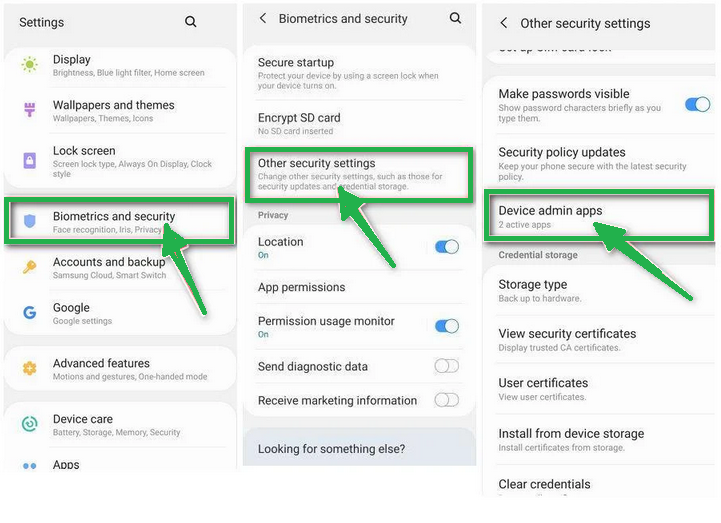
If you can't find "Device admin apps" easily, you can use your phone's search function to look for it.
- Once you're in the list of device admin apps, disable admin rights by tapping the option next to the app. This will remove the checkmark or turn off the toggle button. Some phones also let you tap the app in the admin apps list and then use the "Uninstall" link to remove it immediately.

Step 3: Check for Malicious Apps
While your phone is still in Safe Mode, we'll check for malicious apps.
- Tap the "Settings" app.

- In the "Settings" menu, tap on "Apps" or "App Manager" to view all installed applications on your phone.

- You'll see a list of all installed apps. Scroll through the list and look for any suspicious apps that you don't remember downloading or that don't seem genuine. Malware is often hidden in apps like photo editors, weather apps, or camera apps.
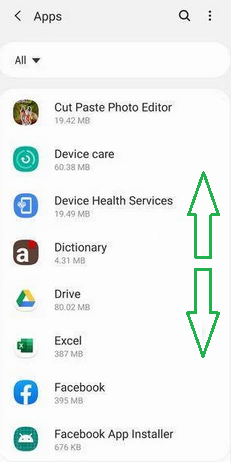
- When you find a suspicious app, tap on it to uninstall. This won't open the app but will take you to the app details screen. If the app is currently running, tap "Force stop," then tap "Uninstall."

- A confirmation dialog will appear. Tap "OK" to remove the malicious app from your phone.

Step 4: Exit Safe Mode
Now that you've removed the malicious app from your phone, you can exit Safe Mode.
- Hold down the power button until you see the power off menu.
- Select the restart option. Your phone will reboot and exit Safe Mode, returning to normal operation.
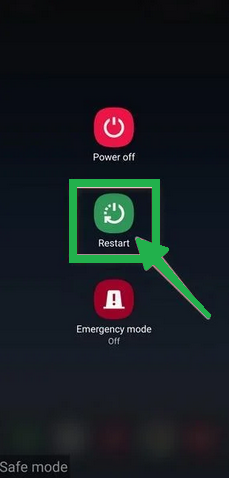
By following these steps, you can effectively remove a Unwanted program virus from your Android phone and restore its security.
How to Reset Browsers
How To Reset Chrome to Default Settings
Reset Chrome for Windows
Here's a step-by-step guide to reset Google Chrome on Windows:
- Launch Google Chrome on your computer.
- Look for the three vertical dots in the top right corner of the Chrome window. Click on them to open a menu. Then, select "Settings" from this menu.
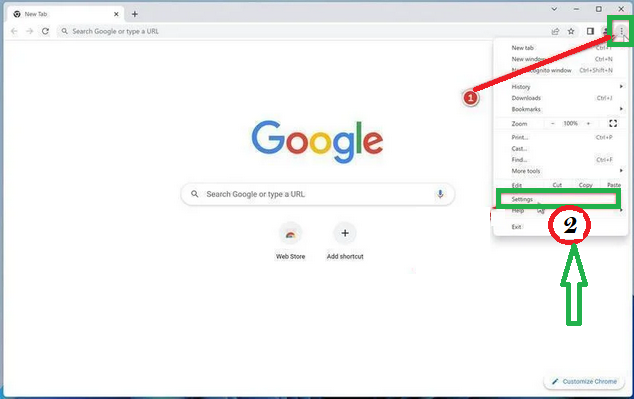
- In the Settings tab that appears, you'll see a sidebar on the left. Click on "Advanced" to get more options.
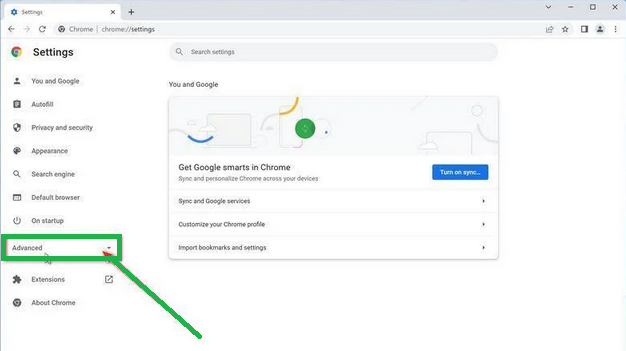
- Under the "Advanced" section in the sidebar, you'll find "Reset and clean up." Click on it.

- Now, in the main part of the window, you'll see the "Reset and clean up" section. Click on "Reset settings to their original defaults."
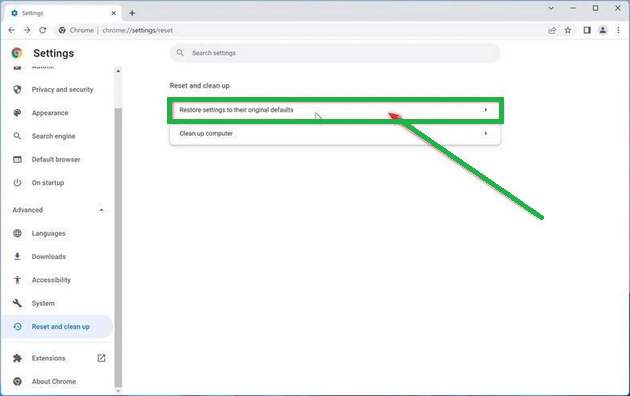
- A window will pop up to confirm the reset. It will explain what will go back to the default settings. If you're okay with that, click on "Reset settings."
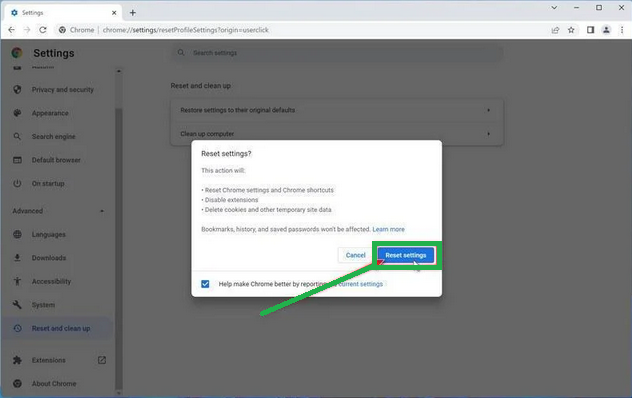
- If you find that a troublesome extension keeps coming back even after the reset, you can reset the data sync. To do this, go to chrome.google.com/sync and click on "Clear Data."

Reset Chrome for Mac
If you're using Google Chrome on a Mac and want to reset it back to its default settings, follow these steps:
- Click on the three dots in the top-right corner of Chrome (the menu button).
- Select "Settings" from the menu that appears. This will open the basic settings screen.

- In the left sidebar, click on "Reset and clean up."

- Now, click on "Reset settings to their original defaults."
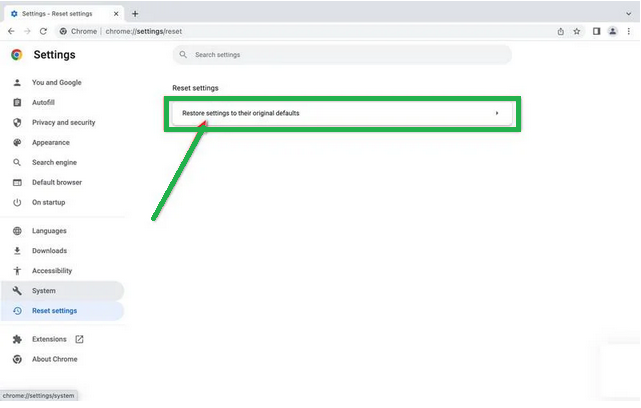
- A confirmation box will pop up, telling you what will be set back to the default settings. To complete the process, click on "Reset Settings."

Keep in mind that doing this will erase your homepage, tab settings, saved information, browsing history, and cookies. It will also disable any extensions you've installed. However, your bookmarks will be safe.
- If you're still having trouble with a malicious extension coming back even after resetting your browser, you can reset your data sync. To do this, go to chrome.google.com/sync and click on the "Clear Data" button.
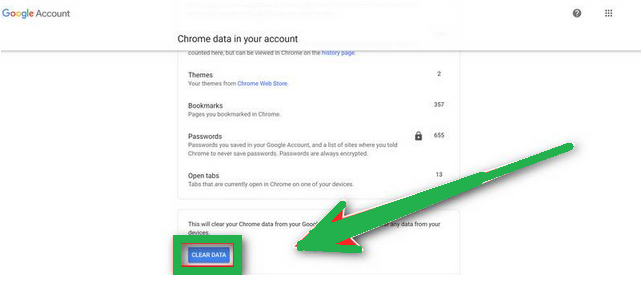
Reset Chrome for Android
Resetting Chrome to its default settings on Android isn't as straightforward as on computers, but it's doable by clearing the app data. This means getting rid of saved cookies, cache, and site settings. Here's how to do it:
- Open the "Settings" app on your Android device. You can usually find it on your home screen or in your phone's app menu.

- In the "Settings" menu, look for "Apps" or "App Manager." This will show you a list of all the apps installed on your phone.

- Scroll through the list until you find the "Chrome" app, and then tap on it to view the app's details.

- Inside Chrome's app info menu, tap on "Storage."
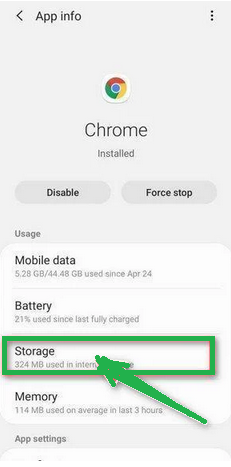
- Under the storage settings, you'll see two options – "Manage Space" and "Clear Cache." Click on "Manage Space."
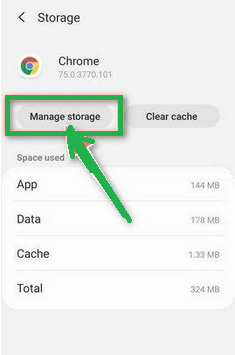
- Now, click on "Clear all Data." This will delete everything related to Chrome, including your accounts, bookmarks, and settings, essentially resetting it to its default state.

- A confirmation message will pop up, explaining what will be reset. To finish the reset process, tap "OK."

How to Reset Internet Explorer
Resetting Internet Explorer is an easy process and only takes a few minutes. Here's how you can do it:
- Open Internet Explorer, which is your web browser.
- Look for a little gear icon in the top-right corner of the browser and click on it.

- Then, select "Internet Options."

- In the "Internet Options" box, click on the "Advanced" tab.
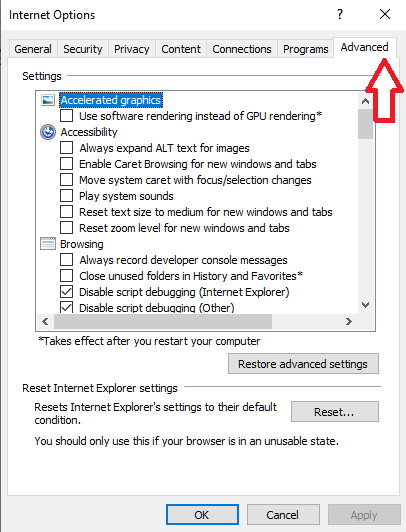
- You'll see a "Reset" button. Click on that.
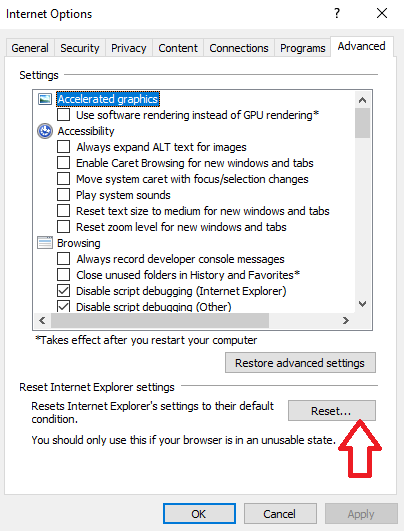
- Now, in the "Reset Internet Explorer settings" section, there's a box that says "Delete personal settings." Check this box, and then click "Reset."

- When Internet Explorer finishes the reset, a message will pop up. Click "Close" to close it. After that, close your browser, and you can open Internet Explorer again.

How To Reset Mozilla Firefox
Reset Firefox for Windows
- Click on the three horizontal lines in the top right corner of Firefox to open the menu. Choose "Help" from the menu.

-
- In the "Help" menu, tap on "More troubleshooting information."

- On the "Troubleshooting Information" page, find the "Refresh Firefox" button and click it.

- Confirm the reset by clicking "Refresh Firefox" again in the new window that pops up.

- Firefox will close and go back to its default settings. It will show you what information it saved. Click "Finish" when it's done.
After the reset, you'll see a folder called "Old Firefox Data" on your desktop. It holds your old settings. If the reset didn't solve your problem, you can copy some of the files from this folder to the new profile that was created. But if you're sure you won't need this folder anymore, it's a good idea to delete it since it might contain sensitive information.
Reset Firefox for Mac
Resetting Firefox on a Mac is easy. Here's what you do:
- Click on the three horizontal lines in the top right corner of Firefox to open the menu. Select "Help" from the menu.

- Then, choose "Troubleshooting Information."

- On the Troubleshooting page, you'll see a "Refresh Firefox" button in the upper-right corner. Click on it.

- Confirm the reset by clicking "Refresh Firefox" again in the new window.

- Firefox will close and go back to its default settings. It will show you what information it saved. Click "Finish" when it's done.
That's it! Resetting Firefox on your Mac is a quick way to make it work better while keeping your important data safe.
Reset Firefox for Android
Resetting Firefox to its default settings on Android is a bit different but still doable. It involves clearing the app's data, which includes cookies, cache, and saved site settings. Here's how you can do it:
- Open your phone's "Settings" app, which you can find in your menu or on the home screen.

- In the "Settings" menu, look for "Apps" or "App Manager." This will show you all the apps installed on your phone.

- Scroll through the list of apps until you find "Firefox." Click on it to open the app's details.

- In Firefox's app menu, click on "Storage."

- In the storage settings, you'll see two options: "Manage Space" and "Clear Cache." Click on "Manage Space."

- Now, click on "Clear all data." This will delete all of Firefox's data, including your accounts, bookmarks, and settings, effectively resetting it to its default state.

- You'll see a confirmation message that explains what will be reset. To complete the reset, tap "Ok."
How To Reset Edge to Default Settings
To reset Microsoft Edge on your computer, follow these simple steps:
- Click on the three horizontal dots in the top-right corner of Microsoft Edge to open the menu. From the menu, select "Settings."

- Tap "Reset Settings" on the left side of the window.

- Now, click on "Restore settings to their default values" in the main window.

- A confirmation message will appear, explaining what will be reset. To proceed, click "Reset."
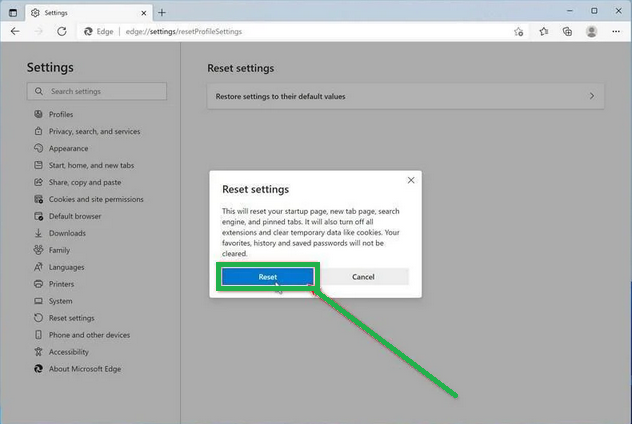
- Microsoft Edge will erase your personal data, browsing history, and disable any installed extensions. But don't worry, your bookmarks will remain safe and accessible.
How To Reset Safari
Before resetting Safari to its default settings, if you have bookmarks you want to keep, open Safari, go to the "File" menu, and choose "Export Bookmarks." Give your backup a name and save it.
To reset Safari on a Mac, you can use the Settings menu or Terminal. If you're using Safari on an iPhone or iPad, tap the iOS tab to reset the settings. This way, you won't lose your important bookmarks when you reset Safari. It's like making a copy of your bookmarks before cleaning up your browser.
Reset Safari for Mac via Settings
Here's how to reset Safari:
- Click "Safari" in the menu, then choose "Preferences." This opens a new window with your Safari settings.

- Check your homepage in the "General" tab. If it's not what you want, change it.

- Next, click on the "Extensions" tab.

- Look for any extensions you don't remember installing or seem suspicious. It's usually safe to remove them.

- In "Preferences," go to "Websites" and then "Notifications." Turn off the option that allows websites to ask for push notifications.

- In the Safari menu, choose "Preferences" again, then go to "Privacy." Tap on "Manage Website Data".

- Choose "Remove All" to clear website data.

- To show the "Develop" menu, go to the "Advanced" tab in "Preferences" and enable "Show Develop menu in menu bar."

- Click on "Develop" in the menu bar, and then select "Empty Caches" to clear out temporary files.

Reset Safari for Mac via Terminal
To reset Safari on your Mac, follow these steps:
- Open the "Terminal" app (you can search for it using Spotlight with "Cmd + Space").
- Go to the Apple menu at the top-left and choose "Force Quit." Select "Safari" to close it completely.
- Enter the commands one by one in Terminal. It will ask for confirmation to delete files. Type "y" and press "Enter" after each command.
mv ~/Library/Safari ~/Desktop/Safari-`date +%Y%m%d%H%M%S`;
rm -Rf ~/Library/Cache/*;
rm -Rf ~/Library/Caches/Apple\ -\ Safari\ -\ Safari\ Extensions\ Gallery;
rm -Rf ~/Library/Caches/Metadata/Safari;
rm -Rf ~/Library/Caches/com.apple.Safari;
rm -Rf ~/Library/Caches/com.apple.WebKit.PluginProcess;
rm -Rf ~/Library/Cookies/*;
rm -Rf ~/Library/Cookies/Cookies.binarycookies;
rm -Rf ~/Library/Preferences/Apple\ -\ Safari\ -\ Safari\ Extensions\ Gallery;
rm -Rf ~/Library/Preferences/com.apple.Safari.LSSharedFileList.plist;
rm -Rf ~/Library/Preferences/com.apple.Safari.RSS.plist;
rm -Rf ~/Library/Preferences/com.apple.Safari.plist;
rm -Rf ~/Library/Preferences/com.apple.WebFoundation.plist;
rm -Rf ~/Library/Preferences/com.apple.WebKit.PluginHost.plist;
rm -Rf ~/Library/Preferences/com.apple.WebKit.PluginProcess.plist;
rm -Rf ~/Library/PubSub/Database;
rm -Rf ~/Library/Safari/*;
rm -Rf ~/Library/Safari/Bookmarks.plist;
rm -Rf ~/Library/Saved\ Application\ State/com.apple.Safari.savedState;
Reset Safari for iOS (iPhone or iPad)
To reset Safari on your iPhone or iPad, follow these steps:
- Open the "Settings" app.
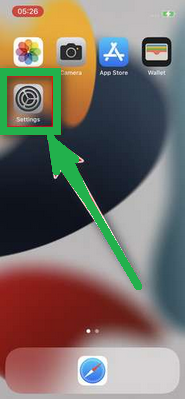
- Turn on "Airplane Mode" to disconnect from the internet temporarily and block unwanted access.
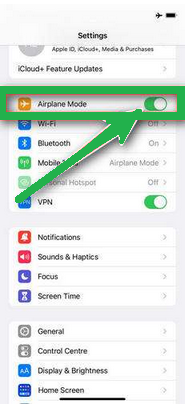
- Scroll down and click on "Safari."

- Now, choose "Clear History and Website Data."

- Confirm by tapping "Clear History and Data" in the pop-up window.
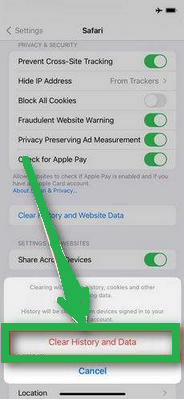
- While in Safari settings, make sure to turn on "Block Pop-ups" and "Fraudulent Website Warning."

These steps clear your browsing history, website data, and other information stored by websites you visited. Also, by enabling "Block Pop-ups" and "Fraudulent Website Warning," you can enhance your browsing experience and protect yourself from unwanted ads and potentially harmful websites.
Recommended Security Software (SpyHunter)
SpyHunter acts like a guardian for your computer, shielding it from nasty stuff like malware and spyware. Using smart scanning, it hunts down and kicks out harmful programs sneaking around your system. It’s not just a detective; it also stops new threats from barging in. Anyone, whether tech-savvy or not, can easily use it because of its simple design. Plus, it keeps learning and gets regular updates to stay ahead of the bad guys. If you want a solid defender for your PC against digital troublemakers, SpyHunter is a reliable choice, always ready to keep your computer safe.
Step 1: Download SpyHunter 5 for your device through the provided link. Obtain it by clicking below.
Step 2: Proceed to the location where the installer is saved in your system. Typically, the file is stored in the “Downloads” directory. Execute the setup process by double-clicking on the installer file.

Step 3: Choose your desired language and press the “OK” button. This action triggers the installer initialization. When prompted, click the “Continue” button to proceed with the installation process.

Step 4: During installation, you’ll encounter a prompt to approve the ‘EULA and Privacy Policy.’ Opt for ‘I accept the EULA and Privacy Policy’ and then select the ‘Accept & Install’ button. This step is necessary to proceed with the installation process of the application.

Step 5: Initiate the installation process, and observe the progression through the visible progress bar. The process may require some time for completion. Once finished, a notification confirming successful installation will be displayed.

Step 6: Upon installation completion, SpyHunter will automatically launch. The following screen will be displayed for your attention.

Step 7: Additionally, the scanner will initiate a comprehensive scan of your computer to identify potential threats within your device. Throughout the scan, it will present you with information such as the detected threat’s name, security level, and specific details about the threat. Relax and wait for the scan process to conclude.

Step 8: Upon completion of the scan, press the “Next” button to continue the process.

Step 9: To finalize the removal process, the application will prompt you to purchase its licensed version. Alternatively, you have the option to opt for a 7-day free trial, during which the software will be fully operational, allowing you to eliminate all identified threats.

Special Offer
In order to remove Sonalez.com hassle free, we suggest you to scan the PC with powerful SpyHunter antimalware scanner. The fully functional free Trial of SpyHunter is Available for 7 days (Windows Version) with Credit Card required. There are no upfront charges within this period. Further, no charge will apply if you cancel 2 business days before the trail ends. For Mac Users, it is suggested to use Combo Cleaner which is a powerful antivirus and System optimizer.
Do make sure to read SpyHunter’s EULA and Privacy Policy. Spyhunter free scanner downloaded just scans and detect present threats from computers and can remove them as well once, however it requires you to wait for next 48 hours. If you intend to remove detected threats instantly, then you will have to buy its licenses version that will activate the software fully.

